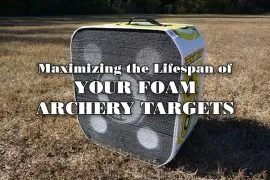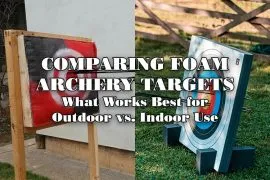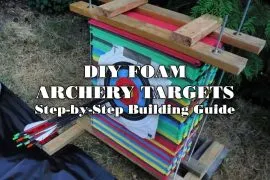The ultimate guide to choosing foam for archery targets involves understanding the critical factors influencing performance, durability, and safety. Archery, a sport with ancient roots, has evolved significantly, with equipment advancements enhancing the experience. Foam targets represent one of these advancements, providing archers with reliable, durable, and versatile options for practice and competition. This guide covers essential considerations, including foam types, density, durability, arrow compatibility, environmental factors, maintenance, and cost-effectiveness, to help archers make informed decisions.
Understanding Foam Types
Table of Contents
Foam targets are made from various materials, each offering unique benefits. The most common types include:
Polyethylene Foam
Known for its high density and durability, polyethylene foam targets are wear-resistant and offer excellent stopping power for arrows. They are ideal for outdoor use due to their water-resistant properties.
Ethylene-Vinyl Acetate (EVA) Foam
EVA foam is softer and more flexible than polyethylene, providing good arrow-stopping capability and easier arrow removal. Its resilience makes it suitable for frequent use.
Polyurethane Foam
This type is lighter and more affordable, balancing durability and ease of arrow extraction. It’s suitable for beginners and casual archers.
Density and Durability
The density of the foam affects both the target’s lifespan and its effectiveness in stopping arrows. Higher-density foams offer excellent durability and are better at stopping high-speed arrows, making them preferable for compound bows and crossbows. However, they may be more challenging for arrow removal. Lower-density foams are easier on arrows and archers but may wear out more quickly.
Arrow Compatibility
Choosing the right foam target also depends on the type of arrows you use. Broadhead arrows, for example, require tougher, higher-density foam to prevent damage and ensure safety. Field tips are more forgiving and can be used with a broader range of foam densities. Consider the type of Archery you practice and select a foam that matches your arrow’s needs.
Environmental Considerations
The environment in which you’ll use your foam targets plays a significant role in your choice. Outdoor targets must withstand weather elements like rain, UV exposure, and temperature fluctuations. Look for UV-resistant and waterproof foam materials to ensure longevity. Indoor targets may not need these properties but should still be durable and safe for repeated use.
Maintenance and Longevity
Maintenance is crucial for extending the life of your foam targets. Regular inspection for wear and tear, rotation to ensure even usage and proper storage away from direct sunlight and moisture can help maintain their integrity. Certain foam targets feature replaceable cores, offering a cost-effective method to prolong their lifespan without the need to replace the entire target.
Cost-Effectiveness
While the initial cost is necessary, the actual value lies in the target’s durability and maintenance needs. Investing in a slightly more expensive, high-quality foam target can be more cost-effective in the long run if it offers superior durability and requires less frequent replacement.
Safety Considerations
Safety should never be compromised. Ensure that the foam density and type are appropriate for the bow’s draw weight and the arrow’s speed to prevent pass-throughs and ricochets. Additionally, consider the target’s stability and secure it properly to prevent tipping or movement during use.
Conclusion
Choosing the proper foam for your archery targets is a multifaceted decision that impacts your practice quality, safety, and budget. Archers can select targets that meet their specific needs by considering the types of foam, their densities, compatibility with different arrows, environmental resilience, maintenance needs, cost-effectiveness, and safety. Whether you’re a beginner, a seasoned competitor, or a recreational archer, the right foam target can enhance your archery experience, providing reliable performance and lasting durability.
Faq’s
Q1. What are the best types of foam for archery targets?
The best types of foam depend on your specific needs, including the type of Archery you practice and environmental conditions. Polyethylene foam is highly durable and excellent for outdoor use, EVA foam balances durability, and arrow removal ease and polyurethane foam is lighter and suitable for casual practice or beginners.
Q2. How do I choose the right foam density for my archery target?
Choose a higher-density foam if you’re using high-speed arrows or if durability is a priority. Lower-density foam may be sufficient for lighter use or practice with lower draw-weight bows. Consider the type of arrows you use; broadheads may require denser foam to prevent damage.
Q3. Can foam archery targets be used outdoors?
Yes, many foam archery targets are suitable for outdoor use. Look for targets made from weather-resistant materials, such as water- and UV-resistant polyethylene foam, to ensure longevity and performance in various weather conditions.
Q4. How can I extend the life of my foam archery target?
Prolong the lifespan of your foam archery target by routinely rotating it to distribute wear evenly. Store it in a dry place away from direct sunlight when not in use. If the center core is replaceable, repair or replace it when needed. Proper maintenance is vital to prolonging your target’s usability.
Q5. Are foam archery targets safe for all types of arrows?
Foam archery targets can be safe for various types of arrows, including field tips and broadheads, but it’s essential to choose a foam density that matches the arrow’s design and the bow’s draw weight. High-density foams are generally safer for high-speed and broadhead arrows as they reduce pass-through risk.
Q6. How do I prevent my foam archery target from tipping over?
Ensure your foam archery target is stable by placing it on a flat, even surface and using a stand or support designed for archery targets. Some targets come with anchoring systems or can be weighted down to prevent tipping during use.
Q7. Is it cost-effective to invest in a high-quality foam archery target?
While high-quality foam archery targets may have a higher upfront cost, they are generally more durable and offer better performance over time, making them a cost-effective investment. They are more resilient to impacts and need replacement less often, leading to long-term cost savings.
Q8. Can I repair a damaged foam archery target?
Some foam archery targets can be repaired, mainly if the damage is localized. Techniques include filling holes with similar foam material or using adhesive designed for foam. However, extensive damage might require replacing the target or its core.








